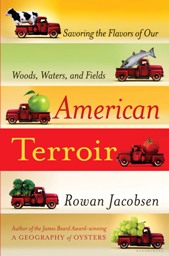
American Terroir: Savoring the Flavors of Our Woods, Waters, and Fields
by Rowan Jacobsen
–Reviewed by Christine C. Chen
 If foodies have “organic,” “local” and “slow,” then wine-lovers can claim “terroir” as their buzzword. Yet the use of terroir needn’t be so restricted. In American Terroir, James Beard Award-winning author Rowan Jacobsen brings the concept out of the wine cellar and onto the table.
If foodies have “organic,” “local” and “slow,” then wine-lovers can claim “terroir” as their buzzword. Yet the use of terroir needn’t be so restricted. In American Terroir, James Beard Award-winning author Rowan Jacobsen brings the concept out of the wine cellar and onto the table.
As with so many other things in the gastronomic galaxy, the English-speaking world adopted the term from the French, who had more than just geography and geology in mind when they coined it. Terroir, from the Latin for “earth,” signifies more than “a taste of place.” It also conveys “a partnership between person, plant, and environment to bring something unique into the world.” Terroir is more than just the soil in which the grapes are grown or the village which lends its name to a wine; it’s the fullest, most concentrated expression of a person’s interaction with the land on which he or she lives.
Jacobsen explores the concept of food terroir in twelve lively chapters that each focus on a particular food – from the humble apple to the exotic oyster – the environment that creates it, and the people who grow and produce its most prized, sought-after incarnations. “Coax” and “craft” might be better at describing the process. As Jacobsen emphasizes throughout, the creation of such ambrosial food does not require human interference or tinkering, but rather, it requires an awareness of and respect for place, and for the plant or animal. To adopt a one-size-fits-all approach – to produce mass quantities of Red Delicious apples or generic Iowa potatoes – is to ignore the very essence of the food.
Not every plant or animal thrives under the same conditions, even those conditions we tend to think of as ideal – good light and rich soil. There turns out to be a surprising connection between struggle and excellence among plants. Grapevines and sugar maples often produce superior wine and syrup under poor soil conditions, which force the plants and trees to concentrate their scant resources and develop large root systems that can absorb more minerals, and hence more flavor.
This insight has implications for more than just taste. As Jacobsen shows, by understanding how a living thing adapts to a place, we come to understand ourselves as inhabitants as well. It’s difficult to think of the hardy sugar maple without thinking of the hardy people who have carved out a life in harsh northeast climes, and Jacobsen keeps them in mind. But he also knows that American identity is only partly about roots. In describing that most American of fruits – the apple – and its long journey from the mountainous forests of Central Asia to the arid eastern plains of Washington state, Jacobsen writes, “It makes an important point about terroir: Mimicking nature is not always the goal, (as Europe’s winemakers learned long ago). Sometimes, like William Faulkner, a thing achieves its best expression in its native landscape. Sometimes, like Cormac McCarthy, it has to head west to find itself.”
Jacobsen is hardly the first to broach the subject of artisanal and local food, although he might be the most unpretentious. His message is a simple reminder that we should pay attention to where our food comes from, not necessarily from faddish motivations or environmental concerns – although the environment certainly benefits when we buy what’s in season locally. Food simply tastes better, he shows, when it doesn’t come in a shrink-wrapped package shipped from halfway across the world. Jacobsen isn’t concerned with the socioeconomic issues raised by what he calls “good eating.” The accessibility and affordability of such food for the average consumer is beyond the scope of his book. His book is, he writes, a romance about good eating, and what makes eating good, and most of all, a love story about our vast and varied land.
Buy the Book: Skylight, Powell’s, Amazon, Borders
Further Reading: A Geography of Oysters by Rowan Jacobsen and Four Fish by Paul Greenberg.
Christine C. Chen teaches humanities at St. John’s College in Santa Fe, New Mexico and is also a professional violinist.
*Photo courtesy Alpha.




Send A Letter To the Editors